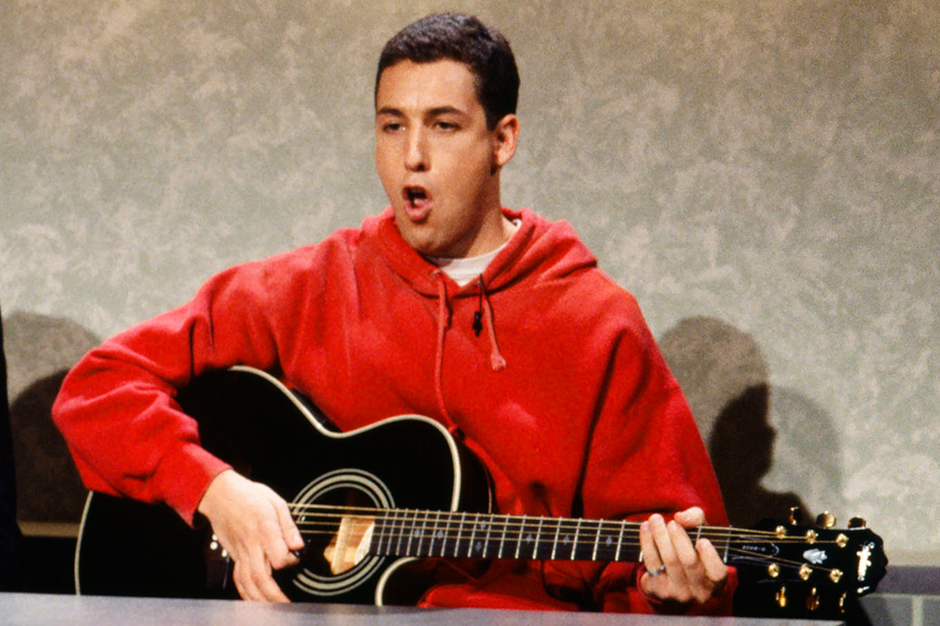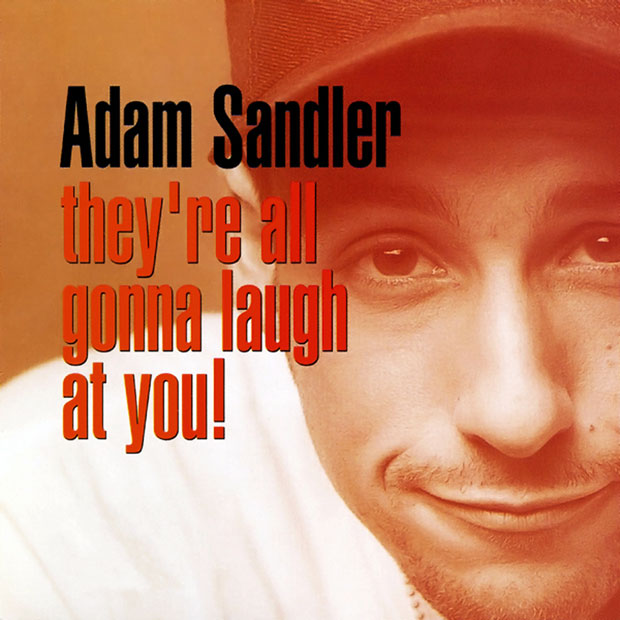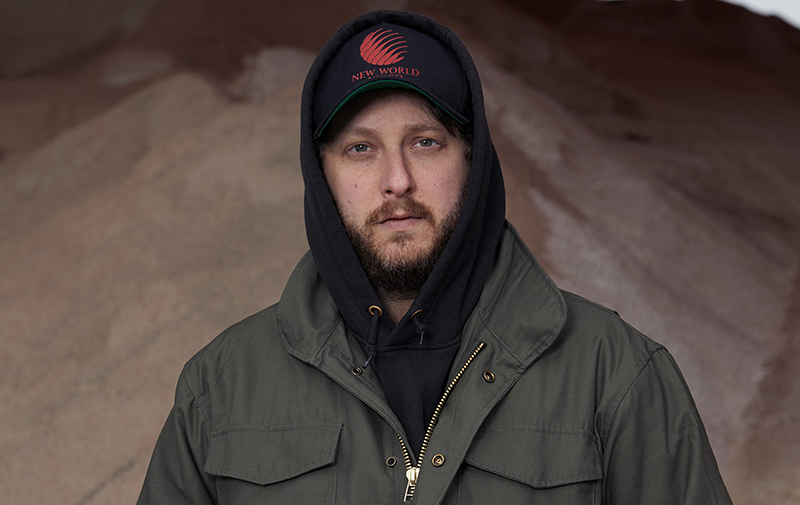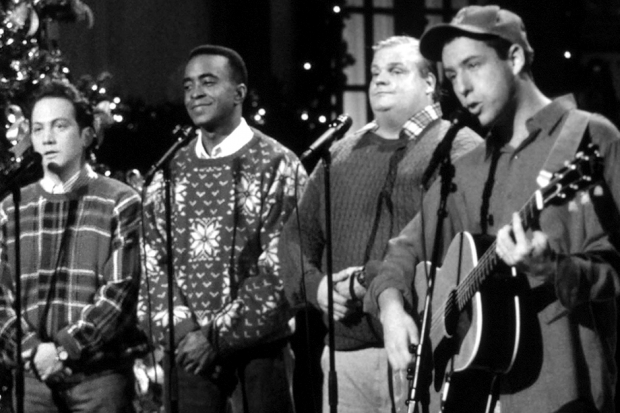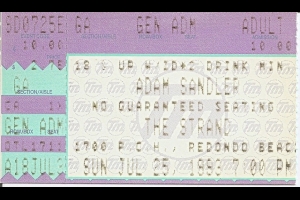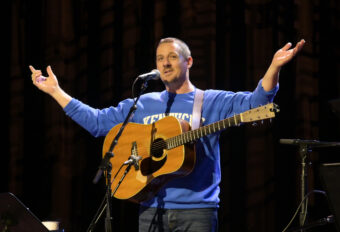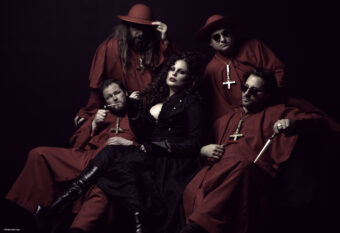During his first three seasons on Saturday Night Live, Adam Sandler’s best and funniest characters included a mushmouthed man-child in a straw hat, a hanky-waving divo who sang the news, and a moron of indeterminate age oblivious to the advances of a lecherous scoutmaster. His comedy was as gleefully juvenile as SNL ever got, and still, like a 12-year-old substituting “privates” for “dick” in a joke when the grown-ups are around, Sandler was also reining things in.
The same cannot be said of They’re All Gonna Laugh at You!, Sandler’s debut album. Released on September 28, 1993, and featuring vocal contributions from then-castmates David Spade, Rob Schneider, and Tim Meadows, as well as Conan O’Brien and Judd Apatow, the 22-track effort was raw, unadulterated Sandman — though it came with some help from a writing staff that would ultimately shape the next two decades of comedy via shows like Late Night With Conan O’Brien (Robert Smigel) and Mr. Show (Bob Odenkirk), films like The Wedding Singer (Tim Herlihy) and empires like Happy Madison Productions (Allen Covert). Virtually non-sequitur recurring sketches about a screeching buffoon mixed with insanely detailed sonic evocations of Looney Tunes-style beatings and songs celebrating Thanksgiving turkey and gymnastic sex acts (performed at a medium pace). Sandler was 27 when he recorded this material, and freed from the strictures of network bosses and visuals, he and his friends came up with as pure — and hilarious — a survey of the over-stimulated, under-intelligent, and joyfully offensive American male teenage id as comedy has ever whoopee-cushioned into the world.
While the sarcasm and irony-drenched approach of The Ben Stiller Show and The State may be remembered more as early-’90s comedy bellwethers, They’re All Gonna Laugh at You! was a legit smash, selling more than two-million copies and establishing an audience for Sandler beyond his role as a late-night Gap Girl. Despite the overwhelming popularity, it’s hard to say that Sandler’s album has been influential (though surrealist pottymouths Tom Green or Tim & Eric come to mind), but 20 years on, the LP is still the clearest representation of what Adam Sandler finds funny when left to his own unhinged devices. Here, many of the album’s performers are coming out of the booth.
Adam Sandler: There were skits and songs and stuff I wanted to do but didn’t think I could get on SNL because they were too filthy. So I told Lorne [Michaels] I was interested in making a record and he introduced me to [Warner Bros. Records Chairman] Mo Ostin and we had a nice meeting. Everyone thought I wanted to make a stand-up record, but I wanted to do something more like Cheech & Chong, with sketches and everything. That was the idea.
Tim Herlihy, writer/performer: Sandler was still getting his feet wet on the show, and with SNL you have to write the skit, then run it by the head writer and Lorne, and then get the host to be into it. Doing an album was taking undiluted Sandler right to America.
Judd Apatow, performer: At that moment, Adam hadn’t done almost anything. That’s why he was making an enormous amount of phony phone calls — because he had all this comedic energy and didn’t have a place to put it. At two in the morning, I would walk in his room and he would be making a prank phone call complaining about the turkey sandwiches at Jerry’s Deli. He would be really amused, and no one was in the room with him. So all that energy went into making the record.
Sandler: I don’t know if Mo was that excited about what I wanted to do — recording a stand-up set is a lot cheaper. And I think it’d been awhile since Mo had heard something like the Cheech & Chong or Derek and Clive albums that I liked. But Mo said he knew this guy Brooks who could help me.
Brooks Arthur, producer: I received a phone call from Mo Ostin and Adam’s manager Sandy Wernick, and they asked if I had ever heard of Adam Sandler — of course I had. I even started singing a little Opera Man for them. So Mo said to go have a meeting with Adam down at Paramount where he’s doing Coneheads. I go to the meeting and Adam was in costume at a lunch break. I felt so out of place. But at least we had a meeting of the minds. He was talking great comedy. I’d done Grammy-winning albums with Robin Williams and I’d worked with Jackie Mason and the ideas Adam was telling me about were just as great as those guys.
Apatow: We were all in awe of Brooks, because Brooks was an engineer on some of the great records of all time, and produced a lot of the great records of all time. When you’re a club comic, and suddenly you’re interacting with these legendary people, and they’re helping you get your ideas across, it’s a very special moment: “Oh, we’re going to be allowed to do this for real!”
Allen Covert, writer/performer: Adam had this idea that he wanted the skits to sound like a movie and really fill them up with foley so you could actually visualize what you were hearing.
Sandler: It wasn’t going to cost a fortune, but what I wanted to do was going to cost double or triple what a normal comedy album would cost. If we were going to have the sound of someone taking a leak, I wanted it to sound really good.
Arthur: We found the best sound-effects editors and sound designers that we knew. [They’re All Gonna Laugh at You sound designer] Elmo Weber is at the top of the list. We introduced him to Adam and they hit it off. We didn’t go to a library to get sound effects; we designed the sound effects.
Sandler: If someone was gonna blow some farts, we’d think about how much time there should be between farts and the kind of fart it should be. We took it seriously. Sadly.
Elmo Weber, sound designer: Adam can see what his vision is going to be, and it was my gig to get his vision on tape. If he wanted the pee to sound like it was flowing hard, then slowing down, then flowing hard again, and the best way for me to do that was record a hose in a toilet bowl at the studio bathroom while people were coming in and out…that’s what I was going to do.
Herlihy: At the time we recorded it, I think we felt that the heyday of comedy albums had already passed, so it was fun to try and get in the spirit of the stuff we loved growing up. Sandler lived on 56th street in Manhattan back then, and the Warner Bros. people had given us a tape recorder with a microphone attached and me and Sandler would go out on his deck and do voices and laugh like two idiots for hours. Anyone who saw us must have been thinking, “Are they on drugs?” But the “Buffoon” character came from that.
Covert: I was working as a waiter and Adam would literally call me at work and go, “You got to get off and get over here!” when he had an idea. I’d be like, “Who’s covering my shift?”
Sandler: We were all so young and didn’t know what we were doing. We’d be talking to each other at three in the morning, saying the filthiest things possible. I liked things like The Ben Stiller Show and The State, but I was off in my own world with my comedy. I called Conan [to ask if he’d perform on the album’s “The Buffoon and the Dean of Admissions”], and Conan read it and went, “Oh my god, why are you making me do this?”
Apatow: Adam doesn’t have much interest in being cool or hipper than the room. He’s not fascinated by pop culture. He is purely hilarious in his own space. He’s not about irony. He’s not a smartass. He’s not cynical. He just loves being funny. He’s a Rodney Dangerfield guy.
Covert: Some of the album was stuff Adam had written already. Him and Schneider had written the “Buddy” sketches. “Right Field” was something Adam had written for Saturday Night Live. Other stuff was based on real life: Sandler is from New Hampshire and he would always imitate these crazy New England guys. That’s where “Tollbooth Willie” came from. And at one point we needed another song instead of a sketch, so me, Adam, and Bob Odenkirk sat down in a little kitchenette at the recording studio and wrote “Lunchlady Land,” which was our version of a Springsteen song; Sandler sitting with a guitar and us shouting out lines. Then we faxed lyrics to Herlihy. Faxing: That’s how long ago this was.
Sandler: We just kind of jammed and came up with stuff that I thought would make my friends laugh. It was the shit we would talk about in high school. Schneider and Spade and all my friends from SNL were there and we felt like no one was watching us. It was great. I can see us recording one thing in one room and in the other room Odenkirk and Herlihy were writing something else. It was so much fun.
Apatow: The way he made us laugh when we were hanging out with him — all the different voices and attitudes — he got on the record.
Covert: One of the Buffoon skits was one of the first things we actually finished. I think it’s the one at the drive-in [“The Buffoon and the Valedictorian”]. We had it cranked up in the studio and you could actually hear the footsteps moving away and the gravel crunching and then he stops, and he turns, and he yells to the valedictorian: “I think I’m going to go piss in that guy’s gas tank.” Coming from these huge speakers, I was just like wow. It made me realize we had done what we wanted to do, which was make a complete picture using just sound. I heard that line and was laughing so hard. I was so proud.
Meghan Andrews, performer:: I was 13 years old when I worked on the album [for “Oh Mom…”] and Saturday Night Live was on way past my bedtime. When I showed up to the studio, I recognized David Spade and Rob Schneider but I didn’t know who Adam was. I went into the control room and was watching him do his thing with the prank phone calls and thinking, This guy is crazy! Actually, you know what else? When I showed up, Rob Schneider and David Spade and Adam Sandler were teasing the kid who played my younger brother in the sketch. He was being a good sport and then at one point, he was like, “I’m done,” and just started getting really sad. But the good thing was once they saw he was not up for it anymore, Adam and the guys totally stopped teasing him. I thought, “Well, that’s cool. At least they’re nice guys.”
Arthur: The vibe of the sessions was always major focus, lots of hours, lots of coffee. We had a great vibe going. You could tell when it was going to be funny because the comedians in the room were laughing, and they’re a lot harder to make laugh than civilians. There was also a lot of Chinese food being brought in. Adam was on some diet — Chinese broccoli and chicken, I think. It smelled pretty bad. You know, for multiple reasons.
Sandler: I think most people wanted me to stop eating that.
Weber: Adam walking into the room one time where Brooks and me and Allen were, and he had his dick hanging out through a paper plate with a likeness of Brooks’ face on it — just to get a laugh out of everybody.
Sandler: My dick was definitely involved at some points. Since I’ve gotten kids, we keep the dick in the pants. It’s funny, I remember someone saying about the stuff on the album, “Your kids are gonna hear it one day.” I thought, “Okay, buddy, how’s that gonna affect my life?” Now my kids have barely heard “The Chanukah Song.” It’s a slow process before they’ll be able to hear “At a Medium Pace.”
Herlihy: The process of putting that album together was so freeform and undiluted — that was the attraction. I don’t remember any compromises. We thought it was the funniest thing that had ever been released. Really, we did. We thought it was the pinnacle of comedy.
Arthur: I’ve always viewed a great comedian as not unlike a great guitarist in a rock band. He steps forward and fucking wails his heart out and achieves a great guitar solo. I got the same kind of energy out of Adam. His performances were bigger than life; even the tracks that we did live.
Sandler: We did a couple of the songs live at the Strand [in Redondo Beach, California]. [Chris] Farley was there that night and screaming encouragement the whole time. The crowd had a more electric feel that night because Farley was in the audience. You can single out Farley yelling on “The Thanksgiving Song.” I met him after the show and he was hugging me. He was more excited for me than I was.
Covert: Once the album came out, Adam did have a platform. “The Thanksgiving Song” was something that people knew from Saturday Night Live, and then all of the sudden it was on the radio. We were like, “We got some radio play? That’s so cool.”
Sandler: I had no idea whether or not people would like the album. Mo liked it, but he was probably just being nice. I guess the Jerky Boys were huge at the same time, so maybe people were in the mood. I don’t know. “The Thanksgiving Song” getting on radio helped a lot; it gave some awareness. “The Thanksgiving Song” was a little dirty and then people got the record and we hit them pretty hard with the really dirty stuff. I’ve had a few mothers yell at me over the years that their kids used to listen to the album in the basement.
Arthur: We didn’t see the album budging on the charts for a while. Then little by little, we started to see it come alive. Suddenly, we jump on Billboard‘s Top 200 albums; then we’re in the 90s. Then we fall back to 98 or 100 or 115. And the next thing we knew, man, it was taking quantum leaps forward. It caught on fire. What we discovered was that the college kids in dorms were rocking out to the comedy album. It took a long time to break, and then it broke records. No pun intended.
Apatow: Adam was slowly breaking through on Saturday Night Live, but this was an explosion.
Herlihy: I was surprised it didn’t sell ten million copies. Looking back on it now, I guess I realize it could have tanked.
Covert: Adam would do stand-up shows at colleges on his weeks off and I was his opening act. We started to notice people would start yelling stuff from the album: A dollar twenty-five, pal from “Tollbooth Willie.” It was easy to see that it was catching on.
Sandler: It was before the Internet and things got big in a day. Throughout the year, more and more kids would stop me on the street and scream one of the Buffoon lines or something. One of the biggest things was when Garry Shandling called me up and said “At a Medium Pace” was funny. As a young comedian, Shandling was a big deal. He tells you the truth, if you like it or not.
Herlihy: They’re All Gonna Laugh at You was definitely the purest expression of what we had to say without the filter of movies and studios and networks. I know I already said the word “undiluted” but that’s what it was. If I had one thing on my tombstone, it would be that album. Things change over the years — you change over the years — but in terms of what we all think is funny deep in hearts, that album is it.
Apatow: I hope Adam makes another record, but it becomes trickier. Before you’re married and have kids, you can realize, “Oh, I have three or four months free, I want to do something, the movie isn’t going yet, let’s make a record.” But when you’re older, instead you use that to visit your family in Florida, or you take your kids somewhere. That time slot gets filled.
Sandler: I don’t think, “Man, I wish those days were here again,” but I miss being able to just only think about comedy and not worry about all the other crap, you know? That’s the beauty if youth, it was just about trying to be as funny as we could be. That’s what we were obsessed with. Sometimes, people say I should do another album and it does stop me a little bit in my tracks. I’d love to do it, but it’s putting aside time that’s the problem. I don’t know…there’s other guys doing good stuff, no one needs me. But I’d love to do it — those were some of the best times of my life.

